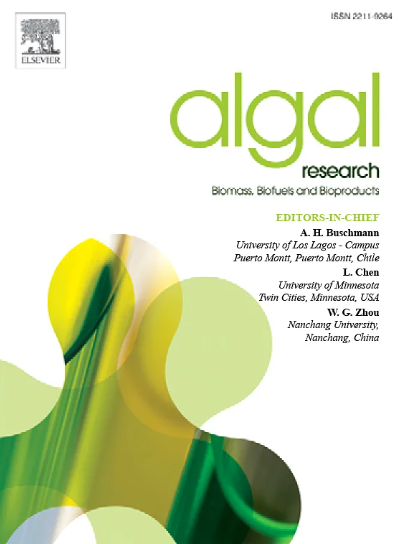Chlamydomonas acidophila for phosphorus recovery from municipal wastewater treatment plants: Effect of light intensity, temperature, different wastewaters and long-term semi-continuous feeding
IF 4.6
2区 生物学
Q1 BIOTECHNOLOGY & APPLIED MICROBIOLOGY
Algal Research-Biomass Biofuels and Bioproducts
Pub Date : 2025-02-10
DOI:10.1016/j.algal.2025.103941
引用次数: 0
Abstract
Recent years have witnessed a growing scientific and regulatory focus on phosphorus (P) in aquatic environments due to its role in accelerated algae growth, negatively impacting water quality. Agriculture and wastewater treatment plants (WWTPs) stand out as major P sources, prompting tightened discharge standards to meet the European Union Water Framework Directive objectives. Microalgae offer a solution for nutrient recovery, but challenges in mass cultivation and light availability persist. This study explores Chlamydomonas acidophila, an extremophilic microalgae, as a viable option for P recovery from WWTPs by understanding the effect of different light intensities and temperatures, as well as the effect of different wastewater characteristics, on C. acidophila growth and nutrient uptake.
Batch assays were conducted using growth media, settled wastewater, and final wastewater at various temperatures (10, 16, 20, 25, and 30 °C) and light intensities (15, 40, and 172 μmol photons m−2 s−1). Furthermore, two 10 L working volume tanks were fed semi-continuously with a hydraulic retention time (HRT) of three days during 200 days at 70 μmol photons m−2 s−1.
The results demonstrated that operational conditions of 20 °C and 40 μmol photons m−2 s−1 were optimal for C. acidophila's biomass production and nutrient uptake. This characteristic significantly enhances the economic feasibility of C. acidophila-based wastewater treatment systems by allowing operation under lower light conditions. C. acidophila's adaptability to fluctuating nutrient levels, continuous nutrient consumption at low light, and mitigation of inhibitory effects make it a promising candidate for wastewater treatment. In a long-term semi-continuous treatment, removals of 3.6 mg PO43− L−1 d−1, 12 mg NH4+ L−1 d−1, and up to 70 mg NO3− L−1 d−1 were achieved. It can be therefore concluded that Chlamydomonas acidophila has high nutrient assimilation capacity at low light intensities and could be a potential candidate for long-term wastewater treatment processes.
求助全文
约1分钟内获得全文
求助全文
来源期刊

Algal Research-Biomass Biofuels and Bioproducts
BIOTECHNOLOGY & APPLIED MICROBIOLOGY-
CiteScore
9.40
自引率
7.80%
发文量
332
期刊介绍:
Algal Research is an international phycology journal covering all areas of emerging technologies in algae biology, biomass production, cultivation, harvesting, extraction, bioproducts, biorefinery, engineering, and econometrics. Algae is defined to include cyanobacteria, microalgae, and protists and symbionts of interest in biotechnology. The journal publishes original research and reviews for the following scope: algal biology, including but not exclusive to: phylogeny, biodiversity, molecular traits, metabolic regulation, and genetic engineering, algal cultivation, e.g. phototrophic systems, heterotrophic systems, and mixotrophic systems, algal harvesting and extraction systems, biotechnology to convert algal biomass and components into biofuels and bioproducts, e.g., nutraceuticals, pharmaceuticals, animal feed, plastics, etc. algal products and their economic assessment
 求助内容:
求助内容: 应助结果提醒方式:
应助结果提醒方式:


